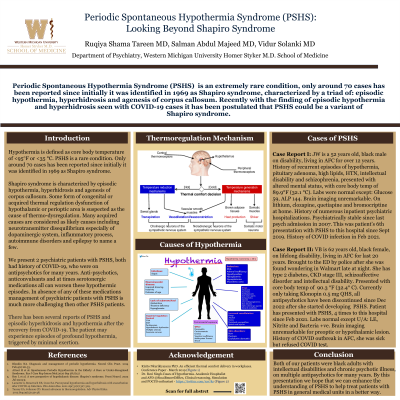Neurocognitive Disorders, Delirium, and Neuropsychiatry
Session: Poster Session
(103) Periodic Spontaneous Hypothermia Syndrome (PSHS): Compelling C-L Psychiatrists to Look Beyond Shapiro Syndrome

Trainee Involvement: Yes
- RT
Ruqiya Shama Tareen, MD
Professor
Western Michigan University Homer Stryker M.D. School of Medicine
Kalamazoo, Michigan, United States 
Salman M. Abdul Majeed, M.D.
Resident, PGYII
Western Michigan Univeisty Homer Stryker M.D. School of Medicine
Kalamazoo, Michigan, United States- VS
Vidur Solanki, M.D.
Resident, PGYII
Western Michigan Univeisty Homer Stryker M.D. School of Medicine
Kalamazoo, Michigan, United States
Presenting Author(s)
Co-Author(s)
Case Report I: 52 yo, black male on disability, living in AFC for over 12 years. History of recurrent episodes of hypothermia, pituitary adenoma, HLD, HTN, intellectual disability and schizophrenia, presented with altered mental status, temp was 89.9 °F (32.1 oC). Labs normal except; Glucose 59, ALP 144. Brain imaging unremarkable. On lithium, clozapine, quetiapine and bromocriptine at home. Pt has had numerous inpatient psychiatric hospitalizations. Psychiatrically stable since last hospitalized in 2007. This was patient’s 6th presentation with PSHS to this hospital since Sept 2019. Case Report II: 62 yo, black female, on disability, living in AFC for last 20 years. Brought to the ED by police after she was found wondering in Walmart late at night. She has recurrent episodes of hypothermia, type 2 diabetes, CKD stage III, schizoaffective disorder and intellectual disability. At presentation her core body temp was 90.3 oF (32.4 oC ). Currently taking Klonopin 0.5mg QHS, all antipsychotics have been discontinued since Dec 2022 after she started developing periodic hypothermia. Patient has presented with PSHS 4 times to this hospital since Feb 2021.
Background: PSHS (<95°F 35 oC) is a rare condition, around 70 cases has been reported since initially it was identified in 1969 as Shapiro syndrome, characterized by episodic hypothermia, hyperhidrosis and agenesis of corpus callosum. Some form of congenital or acquired thermal regulation dysfunction of hypothalamic or perioptic area, neurotransmitter disequilibrium especially of dopaminergic system, inflammatory process, autoimmune disorders and epilepsy has been associated. It has been postulated that PSHS may be a variant of Shapiro syndrome or a different entity on is own. Recently episodic hypothermia seen in severe COVID-19 cases have created a renowned interest in this area.
Discussion: It is interesting that both of our patients were black adults with intellectual disabilities, suffering from chronic psychotic illness, on multiple antipsychotics for many years. Brian imaging of both showed no Peroptic or hypothalamic lesions, no other cases with such characteristics were found on literature search. Medications we could have used for behavioral dyscontrol and psychotic symptoms are contraindicated in PSHS. Both of our patients were on large doses of antipsychotics that when discontinued causes management of these patients on a medical unit very difficult as antipsychotics, anticonvulsants and at times serotonergic medications all can worsen these hypothermic episodes. In absence of any of these medications long term management of psychiatric patients with PSHS is much more challenging then other PSHS patients.
Conclusion: Role of long-term use of antipsychotics is usually blamed for PSHS making it difficult to manage PSHS in psychiatric patients. We hope that we can enhance the understanding of PSHS to help treat patients with PSHS in a better way.
Blondin NA. Diagnosis and management of periodic hypothermia. Neurol Clin Pract. 2014 Feb;4(1):26-33.
Attout H et al. Spontaneous Periodic Hypothermia in the Elderly: A Rare or Under-Recognised Syndrome. Eur J Case Rep Intern Med. 2020 Sep 28;7(12
Ren L et al. A new perspective of hypothalamic disease: Shapiro's syndrome. Front Neurol. 2022 Jul 29;13:91

